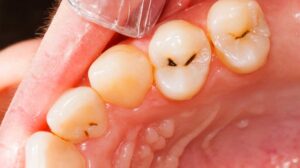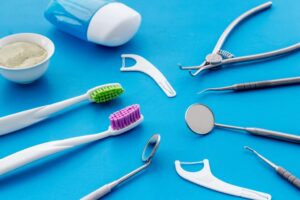
Toothache is one of the most common problems faced by many people globally. Feeling pain in your gums after flossing is a common issue, especially for people using this dental cleaning technique for the first time. While flossing, your gums usually start to bleed and produce intense pain. A question is generally asked by most dental specialists: Why do my gums hurt after flossing? This article will discuss the primary reasons for intense pain after flossing. Before diving into the reasons behind this pain, we must know “What is flossing, and why is it so important?”.
What is Flossing?

Flossing is a method or technique of dental cleaning in which we use a cord of thin filament for interdental cleaning to remove food particles and interdental plaques. It helps to clean between the teeth or places where a toothbrush cannot reach and clean. Flossing is a regular part of our oral cleaning and is designed to maintain oral hygiene.
Why is Flossing So Important?
Flossing is essential for oral hygiene since ignoring food or plaque in interdental spaces or other parts where a toothbrush can’t reach can lead to major dental problems. It helps to prevent the chances of gum disease or tooth decay. Avoiding a healthy cleaning step such as flossing would be an initial step toward gum disease and, ultimately, tooth decay. The food particles and plaques not removed by brushing get stuck between the teeth.
Plaque that piles up between your teeth can lead to the formation of tartar, where you need a dental professional to remove it. The tartar formed here can further lead to the formation of gingivitis, which is the early stage of gum disease. Using a proper method to clean your interdental spaces would be suitable for your oral health.
Is Toothache A Normal Issue After Flossing?
The majority of people feel pain in their gums while flossing. It can lead them to skip their regular flossing schedule or encourage them to discontinue flossing. But if you are serious about your oral hygiene, this toothache or discomfort after flossing your teeth triggers you to discover the actual reason behind this and, ultimately, the method to avoid the pain. These reasons are discussed in this blog in detail.
Why Do My Gums Hurt After Flossing?
Several major reasons cause pain in your gums during or after flossing. These are discussed below:
Sensitive Teeth:
Tooth sensitivity is a major factor if you feel pain in your gums after flossing. Teeth become more sensitive when your enamel, the protective layer on your teeth, is demolished, and dentin, the next layer, is exposed. Dentin contains microscopic tubules that allow acidic foods and temperature variations to reach the nerves and cells inside the tooth. The following reasons can cause tooth sensitivity:

- Gum disease
- Tooth decay
- Fractured teeth
- Worn fillings
To treat this condition, first, you need to find out the reason behind the tooth sensitivity and then treat the issue accordingly. One of the most common treatments suggested by dentists is the use of desensitizing toothpaste.
Gum Diseases:
Gum disease can be one of the most common causes of dental pain after flossing. It is the worst thing that causes toothache with flossing. Gum disease is usually known as Gingivitis and has the following symptoms:
- Bad breath
- Bleeding gums
- Loose teeth
- Swollen gums
Flossing while having gum disease causes pain, but flossing can be the best way to heal gum disease. It removes plaques and tartar, which are the initial stages of gum disease, so it helps to heal your gums.
Tooth Decay:

As discussed earlier, the primary objective of dental cleaning is to remove all the harmful bacteria from your mouth. When these bacteria start building up in your mouth, they can create cavities and infections, ultimately leading to tooth decay in specific areas of the mouth. Flossing in these areas causes intense pain. The best method to cope with tooth decay is to visit your dentist. They will do a deep cleaning to heal tooth decay and remove the pain caused by flossing.
Flossing For The First Time:
The simplest and the most common reason for pain after flossing is doing it for the first time. Flossing requires proper technique; practicing it until you master it takes time. While it is for the first time, you may do it hard, causing your gums to bleed. To avoid this, consult your dentist or watch some “How-to” videos on YouTube. If you are using the correct technique and following all the guidelines but still feeling pain in your gums, there may be another reason for this.
Improper Flossing Techniques:
You may be flossing regularly but still feel pain in your gums. The main reason would be an improper flossing technique. Flossing too hard can cause damage to the tissues between your teeth, or doing it too gently would not be good at all. In this case, you need help to get everything out and achieve the purpose of flossing. Holding dental floss properly is an integral part of this dental cleaning method. The best way to floss your teeth is by guiding the thread between the teeth in a zig-zag motion and gently wrapping it around the side of the teeth. Flossing too hard or vigorously can also cause pain in your gums.
Flossing with Wrong Devices:

Typically, cleaning between the teeth looks like an easy process. However, sometimes, it becomes difficult to detect the food particles hidden between your teeth. You must use proper dental floss or other relevant flossing tools. Flossing is usually done with dental floss or other traditional flossing tools. At some points, people use unusual items instead of dental floss. These items may include cutlery, folding papers, fingernails, safety pins, etc. A study shows that about 41% of the people using these unconventional items feel pain in their gums. If you want to clean between the teeth and avoid dental pain effectively, use the traditional tools meant for interdental cleaning. These items include:
- Dental Picks – These are small dental sticks made of wood or plastic to remove plaque from your gums and teeth. Anyhow, these dental picks are less beneficial than regular floss.
- Tinny Interdental Brushes – These tiny brushes are used to clean between the teeth and are a great alternative to traditional floss.
- Water Flossers – In this, you use a stream of water to eliminate the bacteria, food particles, or plaque between the teeth.
Irregular Flossing Or Not Flossing Enough:
Flossing irregularly or insufficiently can cause pain in your gums, the most common cause of toothache. If you skip a round of flossing or do not follow your flossing schedule, there is a chance that a plaque may start to build up between your teeth. It causes other issues that emerge after plaque builds up between the teeth. Flossing too much is also not as good as people think. Ideally, flossing once a day is good to avoid tooth sensitivity.
Oral Cancer:
Oral cancer can affect any area of the mouth, and gums are one of the most common areas affected by oral cancer. Oral cancer produces bumps that cause pain after flossing. It is one of the more severe and potential causes of soreness in your gums after flossing. Oral cancer can be treated if it is diagnosed in the early stages.
Canker Sores:

Canker sores are small, shallow lesions that develop on the mouth’s soft tissues or at the gums’ base. It is typically a mouth ulcer, also known as an aphthous ulcer. Canker sores can also be a major reason if your gums hurt after flossing. Canker sores usually heal on their own without much effort. But if these sores persist for over two weeks, you must consult your dentist.
Minor Burns:
Eating extremely hot foods or using hot drinks can produce minor burns in your mouth. The minor burns in the mouth can also make your gums hurt after flossing. It causes your gums to become more sensitive and increase the soreness after flossing. Minor burns usually heal independently, and you don’t need to panic.
Other Possible Reasons For Pain After Dental Flossing
There could be other reasons for painful gums after flossing that are not usual but still worth discussing. These reasons are:
Dental Filling – After flossing, you can also experience pain in your gums if you have recently had a dental filling. This pain is usually limited to the affected area where dental filing has been performed.
Hormonal Changes – This minor cause of gum pain after flossing is limited to women. There is a fluctuation in women’s hormonal levels before and during the menstruation cycle and pregnancy. Due to these hormonal changes, women can have swollen, red, and tender gums. This factor is temporary and should resolve on its own.
Using Braces And Retainers – Flossing may cause pain for you if you have braces or retainers. A recent adjustment to your braces usually causes pain in your gums after flossing. However, the flossing technique can also be a major reason if you have braces or retainers. Flossing with a retainer is more difficult than flossing without one. To avoid this, you need to practice the right flossing techniques.
Loose Dental Restorations – Restorations or dental restorations refer to things like crowns over your teeth. These crowns need to be replaced from time to time when they loosen. Changing these loose dental restorations exposes several different nerves. Flossing when you have these nerves exposed usually leads to intense pain. The only way to avoid these issues is to visit your dentist.
Rough Toothbrushes – You may be using the proper flossing technique and following all the above factors to avoid toothache but still feel pain. Now, the main reason would be your toothbrush. A soft-bristled toothbrush will help clean your teeth better than a hard-bristled brush, which can cause bleeding and pain in your gums. Using a hard-bristled toothbrush for too long can make your teeth more sensitive.
How to Floss Properly To Avoid Pain?
After reading these major and minor reasons for pain after flossing, you may wonder, “How to floss properly to avoid dental pain?”. The best thing to do is to follow proper technique and flossing tools. Here are some guidelines to follow that will help you floss correctly and avoid toothache or painful gums after flossing:
- You have to use 18 inches of floss (thread/cord) wound around the middle fingers of both your hands.
- Hold the floss tightly between the thumbs and forefingers.
- After this, insert this thread between the teeth.
- Curve this floss into a “C-shape” against the side of your tooth.
- Then, gently rub it up and down while pressing it against your tooth.
Moreover, you can floss under the gum line, but you must do it gently and slowly to avoid bleeding or damage.
Final Thoughts:
Understanding the reasons why gums pain after flossing is vital for maintaining oral health. From sensitive teeth to using improper flossing techniques, this comprehensive guide will offer insights and solutions to get relief from gum pain. Follow proper flossing techniques to avoid dental discomfort, ensuring a complete and effective dental care routine.


Excellent and very informative article. Well done Dr Asim Amanat Ali.
Thank you!
Great ,very informative article not only for patient but also for dentists to educate their patients.
Well done Dr Asim
Thank you!